The sum total of my cooking efforts this time look like something that oozed out of a soggy… well, I’m not going to say it. I’ll thank you not to say it either (and Benj, whoever you are, that especially means you).
Of course, any Lazy Boy philosopher will insist that things of any significance are always more than the sum of their parts. Then there are the kitchen photographers like me, who come to understand that sometimes the prettiest things are the least photogenic. Somehow those odd ducks are inevitably the tastiest.
I’m not quite ready to show you what a spoonful of my korma, dumped over rice, looked like. I have to sell you on it first. Hence, the cauliflower as the headline photo, because any way you shoot it, this stuff is gorgeous. It’s one of the parts that make up the korma.
Summer produce season is long past, and the autumn crops are beginning to wind down too. Our local farmer’s markets have gone into winter mode, convening just once a month instead of each Saturday. It’s a real adjustment for me. This past weekend, however, the Tower Grove Farmer’s Market had their first winter pantry, and there were still plenty of vibrant veggies to be nabbed. Including the delightfully freakish cauliflower.
These were a new one on me; when I cut into the orange head, I even wondered if it was manufactured, because the yellow runs up the stalks, the way something soaked in food coloring might look.
But no, these are bona fide varieties, The yellow one, called ‘Cheddar’ is the result of a naturally occurring mutation that first showed up in strains of Canadian cauliflower. It’s not just a pretty face; ‘Cheddar’ cauliflower contains a stunning 25 times more Vitamin A than the white varieties. The ‘Purple Cape’ gets its color from the valuable antioxidant group anthocyanin, which is what gives red wine (and purple cabbage, blood oranges, etc) both its color and its nutritional punch.
Now it’s time for a brief semantic debate. Lentils are not beans, you say? You are correct (I’m not in the mood to fight). Not beans, but they do belong to the family. That is, they are leguminosae but not phaseolus. Eh, cut me some slack. We’re getting to the end of the year here.
These Spanish Pardina Lentils were procured from Purcell Mountain Farms. Tiny and pebble-like when dry, these legumes take nearly 45 minutes to cook, which is a pretty long time for lentils. They’re nutty and sharp, with a hint of black pepper on the finish, and they hold their color and shape after they come out of the pot.
Lentils, cauliflower. Combine that with cold, gray and off-and-on damp weather (just the kind I love. Yes, there’s something wrong with me) and it seems that the only suitable food stuff to bring you this week is Indian food stuff.
What is korma, you ask? I wish I could say, but I’m not sure. To avoid any bad korma though, I must give credit where it’s due, to the woman who would know: this recipe is a heavily modified version of the one found at One Hot Stove. Nupur (the blog’s author) taught my friend Amy and me how to make genuine Indian food earlier this year, including this dish. Nupur insists that Indian cuisine is “simple, really”, and it seemed that way too when we were cooking under her supervision. Left to my own devices, things were less efficient. I’m not complaining though – it was exactly what I needed. This is slow food at its best.
I spent half a day grinding, cutting, stirring, pouring, pounding and peeling, soaking in the warmth of the kitchen while mist formed on the windows, making the damp cold outside seem ever more formidable. If it seems like a lot of work, know that you’ll end up with a quantity large enough to feed yourself and your neighbors for a week.
Indian cooking is deeply satisfying. You get to play the alchemist and combine strange spices.
Then there’s the release, as you take all your recent disappointments, annoyances and fears and pound them into one ginger-garlic paste.
Because the flavors are so potent and strong, you get to use whatever lovely vegetables are in season, or in your fridge, and it’s all good. It’s subtle enough that each ingredient shines; at the same time, if you wanted to, you could probably get away with hiding something offensive, like okra, in the mix. Don’t worry, I didn’t.
Korma is a changeling in the mouth, shifting from sweet, savory, hot and spicy notes for a, well a sum total, if you will, that nearly spontaneously combusts on the tongue.
So. Promise me that you won’t leave any comments that make me cry.
You do promise?
Right, then. Here’s what my korma with lentils looked like.
Here’s hoping that yours is even half as homely.
Korma with Multi-colored Cauliflower and Spanish Pardina Lentils
2 tablespoons olive oil
1/2 large onion, diced
2 garlic cloves, minced
2 teaspoons garlic-ginger paste (equal parts fresh ginger and garlic, mashed to a paste in a molcajete).
1 red bell pepper, diced
2 cups winter squash, cubed
2 cups ‘purple cape’ and ‘cheddar’ cauliflower (or white cauliflower), cut into small florets
1 medium carrot, diced small
1 1/2 C tomato puree
1 cup frozen green peas
1 ½ cups Spanish Pardina lentils, cooked
1/2 teaspoon turmeric
1 generous teaspoon red pepper flakes (the Scoville scale is up to you)
salt to taste
1 teaspoon sugar
1/4 cup almonds
1 generous tablespoon poppy seeds
1 teaspoon kasuri methi *
2 teaspoons garam masala (easy enough to buy, but an even better recipe is below)
¾ cup heavy cream (optional) *note — I often use greek nonfat yogurt instead, the effect is the same and the fat is deleted
Brown basmati rice (optional)
* I wish I could tell you what makes this herb so special. All I know is that Nupur told me to buy it, and it smells like fennel, dried grass, maple syrup, and something familiar yet far away. It adds a flavor that is almost wholly not found in home cooking, and I’ve become something of an addict. I found it at our local international foods grocery store – honestly, if you can’t find it, I’ll send you some. But if you use it, be sparing, as it has a distinct presence that can easily be overdone.
To make the almond-poppy seed paste, in a skillet, roast the cashews and poppy seeds until toasted and slightly darkened. Cool for about 10 minutes, then grind in a coffee bean grinder or blender. Set aside.
Add the oil to the same pan. Heat oil on medium-high flame, then add the onion, garlic and ginger-garlic paste. Cook, stirring often, until the mixture is translucent, about 5 minutes. Add the winter squash and carrot and cook for another 5 minutes. Add the cauliflower, and bell pepper and fry for a couple minutes more.
Add turmeric, red chili flakes, salt and half the garam masala mix. Stir around until the spices are aromatic. Stir in the peas, tomato puree, and sugar and heat until warmed. Add the almond-poppy seed paste and stir well. Add 2-3 cups of water, the kasuri methi, and the remaining garam masala and stir well. Simmer for 15-20 minutes on medium-low heat, stirring now and then.
Stir in the lentils and cook another minute or two, until heated through. If using cream, stir this in and warm it gently, being careful not to let it boil or curdle.
Spoon mixture over brown rice and marvel at your accomplishment.
Garam Masala
1 teaspoon cinnamon
1 teaspoon whole cloves
1 teaspoon whole cardamom seeds (note: not the pods)
3 teaspoons cumin seeds
In a spice grinder, combine the cinnamon, cloves and cardamom. Grind for about 20 seconds, or until coarsely powdered. Place in a bowl or jar and add the cumin seeds, and stir to combine.
Tags: garam masala, korma, Momtaz sabzi ghormeh, orange cheddar cauliflower, purple cauliflower, spanish pardina lentils

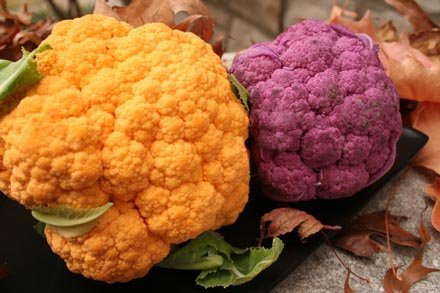
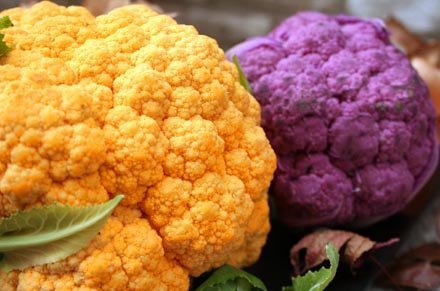
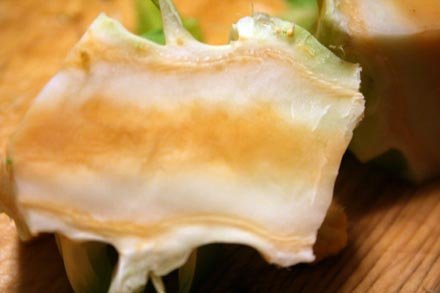
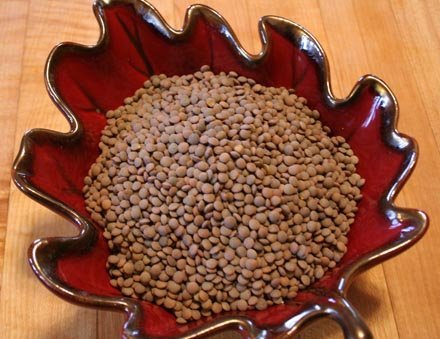
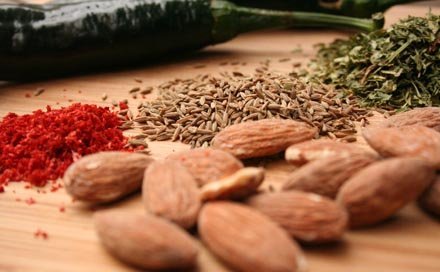
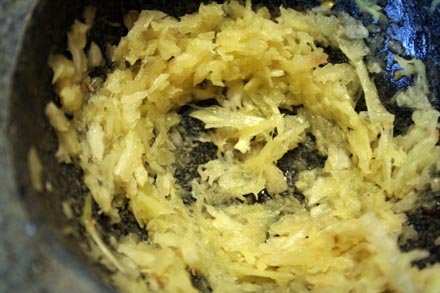
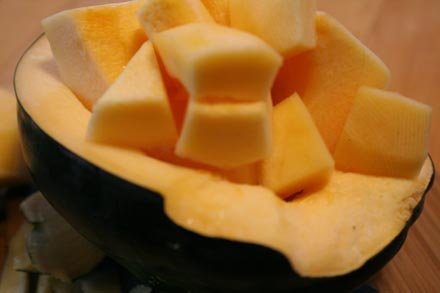
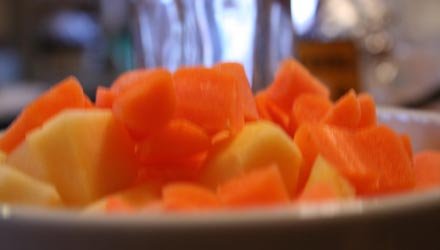
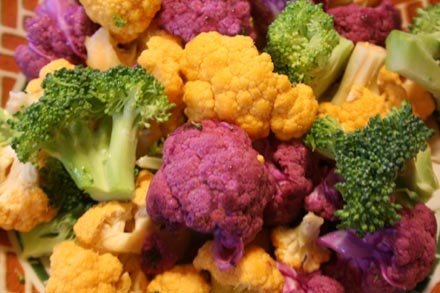


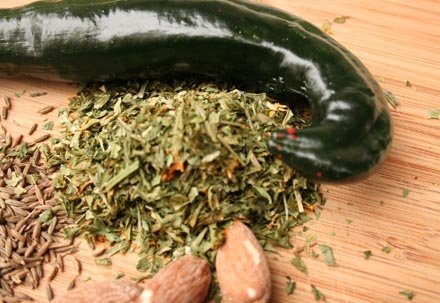
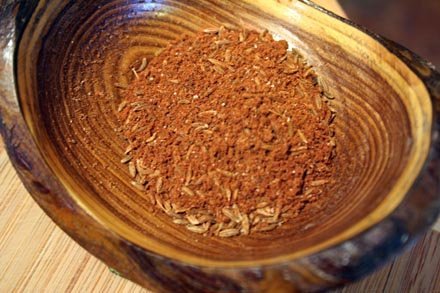
Simply reading your accurate description of the fragrance of the Momtaz sabzi ghormeh transports me back to that sunny day in Nupur’s kitchen, where we became two kids discovering new varieties of candy for the first time. Nupur, if you’re reading, you’re cooking lesson has become the stuff of legend in our eyes. Great adaptation Becky, hope you are still feasting on that delectable-looking (to me anyway) korma!
your posts are a visual feast, even the lumpy korma! i don’t really know what korma is either, but i’ve had it before and i love it. the nice thing about your version here is that it’s not necessarily spicy-hot, which i don’t like.
Awww, Beanstock. I’ve been hanging back, trying to come up with something to say about the Korma that will live up to your expectations but I got nothing. It doesn’t even look that bad to me. A little… muddy, perhaps, but I’d eat it.
I’m a huge Indian food fan,, but I don’t touch it in my own kitchen. It seems way too complicated and I don’t have the patience. I wish I did though. The photos of all the spices are pretty, and I can pretty much smell them from just looking at them!!!
I’m a huge Indian food fan, but I don’t attempt in my own kitchen. It seems way too complicated and I don’t have the patience. I wish I did though. The photos of all the spices are pretty, and I can pretty much smell them from just looking at them!!!
Awww, Beanstock. I’ve been hanging back, trying to come up with something to say about the Korma that will live up to your expectations but… nope, I got nothing. It doesn’t even look that bad to me. A little… muddy, sure, but I’d eat it.
Okay, so the korma isn’t going to make the cover of Saveur Magazine, but the other photos sure do make it up for it. The multicolored cauliflowers are fabulous, and I was surprised that they didn’t seem to lose color when you cooked them.